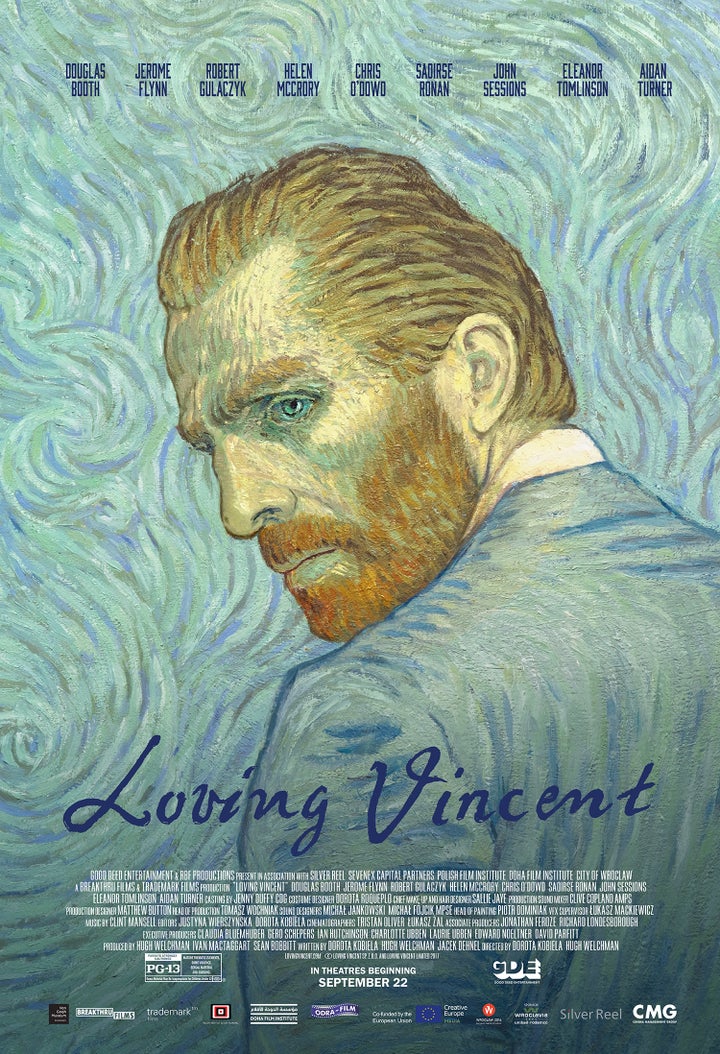
Dorota Kobiela and Hugh Welchman were inspired by the work and life of Vincent van Gogh to create an animated film not just inspired by his art but immersed in it, in the most tactile, literal method imaginable. Instead of traditional hand-painted animation on cells or more recent computer animation with pixels, Kobiela and Welchman found 125 classically trained oil painters to create each frame of the film based on van Gogh’s most iconic images. They used these paintings to tell the story of Armand Roulin (voice of British actor Douglas Booth) the son of a mailman, who is asked to deliver a letter after van Gogh’s death that the artist had written to his brother and closest confidante. Armand retraces van Gogh’s steps and hears different, sometimes conflicting perspectives on his life. In an interview, Kobiela and Welchman talked about the painstaking process of making the film.
Where did you go to find artists who could inhabit van Gogh’s work?
HW: One of the reasons we made the film in Poland is they have quite a rigorous oil painting art education system there so the average time of further education for oil painters is five years of specialist art training. We started with twenty and by the time we got the finance in place we had the same deadline as before and we needed to have one hundred painters. Fortunately for us there was a teaser trailer that went viral around the world and we had four thousand new applications from fifteen different countries.
One of the things that impressed me so much about the film was the tactile quality, almost three-dimensional, and the brilliance of the colors. It really evokes van Gogh’s work. How did you achieve that?
HW: We painted on canvas, seriously; I mean Vincent painted on canvas and we painted on canvas. When they were painting they were looking at the Vincent paintings and they were trying to get the same brush stroke. Piotr Dominiak, our head of painting animation, has been to all the museums taking photographs and we interviewed the experts at the Van Gogh Museum about which Vincent put the paint on, what type of equipment he was using, what exact color he was using so all of that research then went into us replicating and reimagining that on to our canvases.
DK: Our biggest problem that with animation was you have to obviously light the canvas and you need to light it evenly, while in a museum the lighting is directional, so you can see the shadows of the actual paint in them. It was a challenge to make sure the texture is visible on the screen and they were all sculptural.
HW: And once you're committed to a big thick impasto stroke then they have to animate that. They have to scrub it out and leave it a little bit to the right, a little bit to the right, a little bit to the right. So for those big impasto shots they're actually animating every brush stroke.
Why did you decide to go with a different style for the flashbacks, to have them black and white?
DK: Because it's a different story. Armand is in the present and takes us on that journey with the letter following Vincent’s last weeks and discovering facts about his death. He sees Vincent’s world how Vincent saw it and then when he speaks to the people and the characters in his paintings they’ll recollect their own memories. These are the life of Vincent as they remember it. Also many times you have stories that Vincent wouldn’t be able to paint and we wanted to include that in the movie. We did not want to create something that is so far from Vincent’s paintings or have confusion with Vincent’s paintings. Also for me I thought that it might be important to have some kind of rest for the eyes after all these vibrant and pulsating images.
Why did you decide to tell the story of his death instead of following him throughout his life?
HW: There have already been three major biography movies where you deal with Vincent head on and we wanted to take a different approach. From the very beginning it was always going to be bringing the portraits to life to tell their view of Vincent. As you probably know there are a lot of conflicting views about how he was like as a person, what was wrong with him, why he committed suicide, was he ill, was he mad, and so we wanted to use that. And also the thing is about Vincent is that he's beautiful and poetic in his letters and very intelligent and inspiring. His paintings communicate to you very directly but he had a real problem with communicating with people in front of him. So if we do a story about him and he's speaking to us and it's all about how he is with people then we have to go through the problems whereas we felt in this way with we could always keep him a bit hidden so he only looks at us twice in the film, when he's having the argument with Gachet and also at the end when he sits down and you see him in color.
Do you have a favorite Van Gogh painting?
DK: I have a few paintings but it depends very often on the day. Today I think it’s Olive Grove and the Sower in the Setting Sun. I really love the Red Café, the Night Café it’s called but I’m insistent to call it Red Café because that’s how we call it.
HW: I have some shifting but always in my selection is Cafe Terrace at Night and his final self-portrait.
